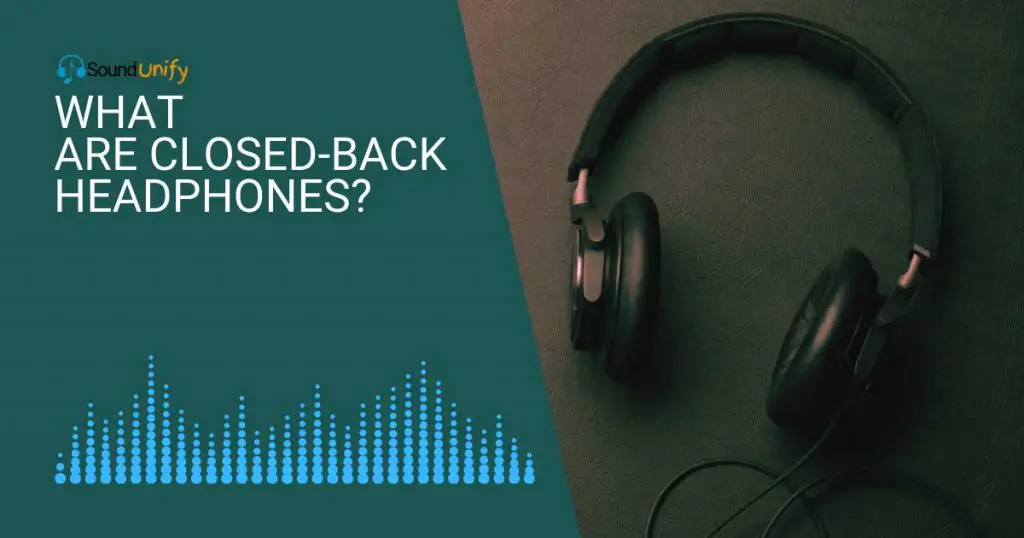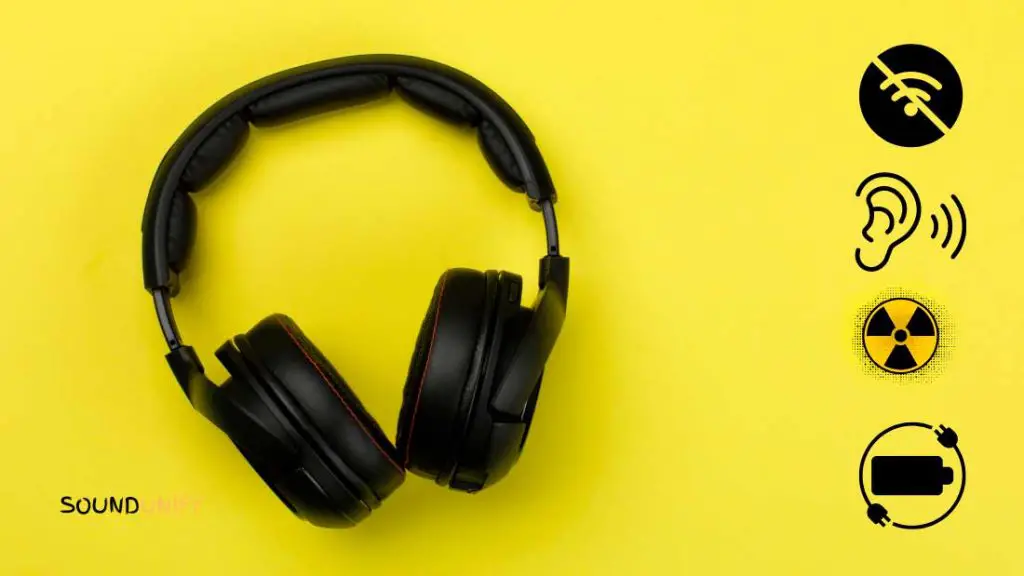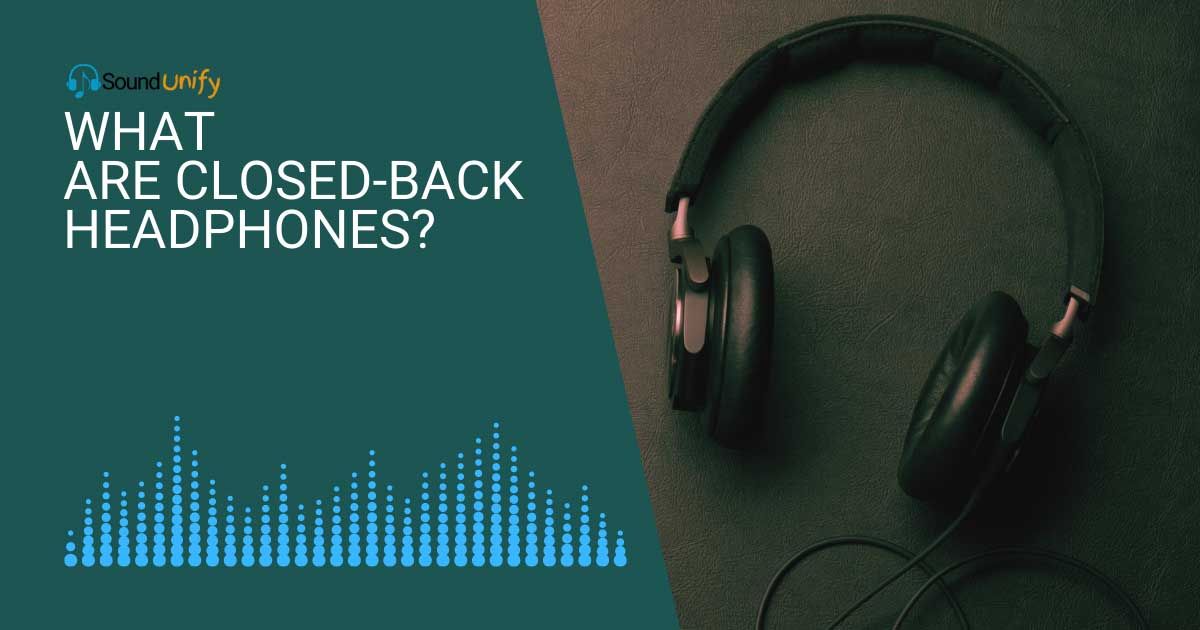Closed-back headphones are a type of headphone design with a partially or fully closed back. They use sound-isolation technology to reduce external noise and improve audio quality.
Audio enthusiasts often prefer them as they provide greater audio detail and a more accurate representation of sound waves.
This guide will discuss the definition of closed-back headphones, their technology, advantages and disadvantages, buying guide, and purpose of use.
So, we are here for you whether you’re looking for the best earbuds for listening to music or want to know more about closed-back headphones.
Closed-back Headphones: Definition

A closed-back headphone is a type of headphone that seals the ear cups around the ear, which helps to isolate sounds and block out distractions from the outside world.
Closed-back headphones are often used by music producers, DJs, and other audio professionals who need to focus on their music without outside interference.
Moreover, closed-back headphones are designed to isolate your ears from ambient noise and improve sound quality. Closed-back headphones are the perfect option if you’re a music lover or want to improve audio quality for videos and gaming.
Types of Closed-Back Headphones
Closed-back headphones are a popular choice for audio lovers, providing noise isolation and a more immersive experience than other headphones. There are four closed-back headphones: in-ear, on-ear, over-ear, and true wireless.
- On-ear headphones are slightly larger and heavier than in-ear headphones, but they’re still relatively compact and easy to transport.
- Over-ear headphones are the most extensive and bulky option, but they offer the best sound quality and noise isolation.
- Wireless headphones are the newest type of closed-back headphones and offer the ultimate portability and convenience.
The Technology That Closed-back Headphones Use
The technology that closed-back headphones use is fairly simple. The main difference is the addition of the seal around the back of the ear cups. This seal is usually made from a foam or rubber material and helps to isolate the sound from the headphones.
This seal helps isolate the headphones’ sound and prevents it from leaking. That is in contrast to open-back headphones, which do not have a seal and allow sound to leak out.
Purpose of Use for Closed-Back Headphones

As closed-back headphones come in different sizes, shapes, and colors, make sure to get a suitable model if you plan to use them for other activities. Some common uses for closed-back headphones are
1. Use in Studio
When used for music or video production, closed-back headphones provide a superior level of sound isolation, which is perfect for making critical audio edits or recording high-quality audio tracks. They are also ideal when recording as they help block out external noise so you can focus on the music.
Beyerdynamic DT 770 is a perfect headphone for musicians. It is a high-quality, professional-grade headphone that is perfect for studio use. They have a comfortable, ergonomic design that is perfect for long hours in the studio. And the sound quality is impeccable, with clear and accurate sound reproduction.
2. For Noisy Environments
It is also an excellent choice for people who want to experience audio in privacy. They are ideal for people who work in noisy environments, such as construction sites or factories.
Though they’re not the best headphone option if you need to hear phone calls or conversations clearly, closed-back headphones provide a more isolated sound that can be perfect for listening to music or watching videos without being disturbed by other noises.
3. In Public Places
They come with various ear pads that provide optimal sound quality and reduce noise levels. That makes them ideal for people who want to avoid being disturbed while listening to their favorite tunes.
You can use closed-back headphones in public places if you reduce ambient noise levels or focus on listening to your music undetected.
4. In The Office
Closed-back headphones are ideal for use in the office as they help reduce distractions and provide an isolating sound environment. They are perfect for people who need to focus on their work without considering noise levels.
The best type of closed-back headphones explicitly designed for an office is those with a good seal around your ear, which prevents outside noise from leaking in and overwhelming you while you’re working. They are also great for when you need some privacy during a meeting.
5. For Streaming
A streaming closed-back headset is a perfect option if you’re looking for a way to enjoy your favorite show or movie without distractions.
It comes in different colors and styles that suit your taste; these headsets are specially designed to reduce external noise while streaming music or videos. They also keep your audio and video quality high, even in noisy environments.
The Audio-Technica ATH-M20x headphones are best for streaming for a longer time. It has unique and comfortable ear pads that make them perfect for long listening sessions.
These are made of high-quality materials, with earcups that can rotate 15 degrees, and have lots of padding on the headband and earpads.
6. To Travel
Closed-back headphones are a great way to enjoy your music while traveling. They block external noise so you can focus on your music or podcast. They also prevent your music from disturbing others.
There are also a few things to remember when using closed-back headphones while traveling.
- Note that they can get hot and uncomfortable after extended use. So, don’t forget to give your ears a break every once in a while
- You won’t be able to hear any ambient noise. So, they may not be the best option for listening to audiobooks or movies while traveling.
- When traveling by plane, take them off during takeoff and landing so you can hear important announcements.
7. To Study
If you’re looking for a way to improve your focus while studying, give closed-back headphones a try because they will help you to focus better on your studies by blocking disturbing ambient noise.
It will create a calm and silent environment that is much needed to focus on your paper.
8. For Gaming
Closed-back headphones are gamers’ first choice. While open-back headphones are fabulous for music listening, closed-back headphones are better suited for gaming.
They provide better isolation so you can focus on the game, and they don’t leak sound, so your teammates won’t get distracted.
The Sennheiser HD 280 Pro is an excellent pair of closed-back headphones for gaming. The FIIO A1 portable headphone Amp gives you the ability to boost the volume and improve the sound quality of your headphones.
The headphones’ closed-back design ensures excellent isolation from outside noise.
Advantages of Closed-Back Headphones
There are many advantages of closed-back headphones. Those are:
1. Better At Blocking Noise
People who work in noisy environments or have a busy schedule need headphones that block out noise. Closed-back headphones offer better sound quality as they do this better than open-back ones.
2. Portable & Comfortable
Closed-back headphones are very comfortable to wear as the earcups are made of foam and don’t restrict head movement. They are also portable. You can take them wherever you want as they are lightweight and easy to carry.
3. Greater Bass Quantity
Due to their bass-rich nature, closed-back headphones are fabulous for music lovers who like listening to tunes with a lot of depth and thump.
They’re also ideal for gamers as they provide superior sound effects and immersion in the gaming experience.
Many professional audio engineers prefer closed-back headphones when mixing audio files due to their clear sound quality and consistent playback time.
4. Less Noise Leakage
Closed-back headphones are designed to create a seal around your ear, which helps to prevent sound from leaking out.
That also means less noise can get in, making them ideal for improving attention span and concentration.
5. Better Sound Quality
Closed-back headphones have better sound quality than open-back headphones for a few reasons.
- They have better isolation, meaning they block out more outside noise. That is important because it allows you to hear the music better without distractions.
- They have more bass because the closed-back design traps the low frequencies. That is ideal for people who want to hear the bassline in their music.
- They also have a more refined sound because the sound is not as open and airy as it is with open-back headphones.
6. Driver Size
Closed-back headphones are popular because they provide a better overall sound quality than open-back headphones.
They have drivers enclosed in the ear cup and vented at the back. This design allows more accurate reproduction of bass, treble, and other audio frequencies.
7. Low Frequencies
Low frequencies are the sound waves that make up the bass range. They’re responsible for a lot of the emotional content in music, and they’re usually delivered best through closed-back headphones.
They block out most of the outside noise, which allows you to listen to lower frequencies more effectively.
They can produce stronger low frequencies than open-back ones because they have a seal around the back of the ear cups.
This seal helps to trap the low frequencies and keep them from escaping, which gives them a boost.
This benefits you by allowing you to hear low frequencies more clearly. You can identify and appreciate musical subtleties better.
You’ll be able to distinguish between different sounds within a track, making it easier to find specific notes or instruments.
Disadvantages of Closed-Back Headphones
Closed-back headphones are a popular choice for audio enthusiasts, but there are a few disadvantages.
1. May Cause Neck and Back Pain
Closed-back headphones are notorious for causing neck and back pain. The design forces the user to pressure the ear, leading to neck pain and tinnitus (ringing in the ears).
Worse, closed-back headphones can also lead to Hearing Loss over time. If you experience any of these problems, it is best not to use them.
2. Some May Have Lower Sound Quality
When it comes to audio quality, open-back headphones tend to outperform closed-back headphones.
That is because they are designed with an open design that allows ambient noise into the audio mix. This increases the overall sound quality as background noise isn’t artificially reduced.
Closed-back headphones, on the other hand, isolate you from the outside world and decrease sound quality. In addition, if you are looking for an immersive listening experience.
Closed-back headphones will not help since they don’t allow ambient noise into your audio mix- making them unsuitable for walking or working out.
3. Can Sweat When Wearing a Long-Time
When wearing closed-back headphones for an extended time, you may experience discomfort or headaches. The pads may be the reason for that.
Closed-back headphone pads are made from soft, pliable materials that conform to your head and can become compressed over time.
This compression can cause pressure points on the forehead and behind the ears, leading to uncomfortable sensations such as sweats, dizziness, and headache. To prevent this issue from occurring in the first place:
- Make sure that your closed-back headphones fit snugly but comfortably against your head.
- Ensure that the pad is evenly cushioned throughout its entire surface area.
- Do not let it sag in any particular spot.
4. It May Be Not Good for Working Out
Closed-back headphones are not recommended for people who want to work out. Because they block out external noise, you can’t hear what is happening around you.
That can lead to dangerous situations, as you may not be able to listen to warnings from your trainer or see potential dangers in the environment.
Moreover, closed-back headphones tend to create a buildup of pressure in your head, which can cause headaches and other symptoms. This way, it can decrease performance and increase the risk of injury.
On the other hand, open-ear earphones allow you to adjust the ambient sound level, making it more comfortable for your environment.
This way, you can hear what’s happening around you without worrying about being distracted by outside noises. Open-ear earphones allow air circulation, which keeps your head cool during workouts.
Consider The Facts Before Buying Closed-back Headphones

Not all closed-back headphones are created equal. Some may better suit specific music genres or certain media consumption types.
It’s essential to choose the right pair of closed-back headphones if you want to get the most out of your audio experience. Here are some tips on how to find the perfect pair:
1. Purpose Of the Headphone
When choosing closed-back headphones, you first consider the type of music you like to listen to. If you’re a fan of electronic music or hip hop, you’ll need headphones that can reproduce the thumping basslines and beats.
Look for headphones with large drivers (the part of the headphone that produces the sound) for the best bass response.
If you prefer classical music or acoustic sounds, you’ll need a pair of headphones that can reproduce the subtle nuances and detail in the music. In this case, look for headphones with smaller drivers.
2. Try Before You Buy
Try out different pairs of closed-back headphones before purchasing is no harm. You can visit an Audible store or listening services like Spotify Premium and Apple Music Unlimited. Both services offer free 30-day trials to test each headphone without committing to anything long-term.
3. Look At Reviews
Another way to determine which type of closed-back headphones is best for you is by reading user reviews online. This will give you an idea of what other listeners have thought about the particular model you’re considering buying.
You’ll also be able to see if any glaring problems with the product have been reported recently, which could indicate future issues.
4. Consider Your Budget
Bear in mind your budget when choosing Closed-back Headphones. Don’t overspend just because they cost more than average earbuds.
A good pair of closed-back headphones may exceed 200$ or more. So, be picky about what you want.
5. Size And Shape of The Headband
Ensure the headband is adjustable enough to fit comfortably on your head. Also, choose models with a curvature inward design.
So they fit more closely against your skull than exterior designs (which may feel less restrictive).
6. Size And Shape of The Cup
Closed-back ear cups should be snug but not overly tight; otherwise, sound quality will suffer. The cups should also have ample padding. So they don’t cause irritation or pressure points around your ears.
7. Ear Pads and Cushioning
Choose ear pads made from soft materials such as memory foam or microfiber cloths to provide maximum comfort during long sessions wearing them. And make sure the cushioning is thick enough to avoid pain or discomfort after prolonged use.
FAQs
Q. Which brands of closed-back headphones are the best value for money?
There are many brands of closed-back headphones that offer great value for money. Some popular brands include Beats, Sennheiser, Sony, and Bose. These brands offer various models that range in price, features, and quality. When choosing a pair of closed-back headphones, you must consider your needs and budget.
Q. How can I tell if my current headphones are closed-back?
Assuming you are talking about over-ear headphones:
An excellent way to tell if your headphones are closed-back is to look at the ear cups. If the ear cups are solid with no vents or openings, your headphones are most likely closed-back.
Another way to tell is by putting the headphones on and seeing if your ears feel enclosed. If they do, then you have closed-back headphones.
Q. How do I choose the right size of closed-back headphones?
There are a few things to consider when choosing the right size of closed-back headphones.
1. First, consider the size of your head. If you have a larger skull, you’ll want to choose headphones that are a bit bigger.
2. Second, consider the shape of your head. If you have a rounder head, you’ll want to choose more oval-shaped headphones.
3. Finally, consider the size of your ears. If you have larger ears, you’ll want to choose headphones that are a bit bigger.
Conclusion
Closed-back headphones are famous for their bass-heavy sound and are an excellent choice for many different types of listening. Closed-back headphones are the way to go if you want to block out external noise or need headphones that won’t leak sound.
We’ve covered everything you need to know about closed-back headphones, from how they work to the best models on the market. Whether you’re a casual listener or a professional audio engineer, we hope you now understand closed-back headphones better and how they can benefit your listening experience.
James Dimento is a Chief-in-Editor of SoundUnify. He is a headphone enthusiast and creative writer passionate about audio technology. He has three years of experience writing about headphones and sound quality and is responsible for creating reviews and taking care of all administration.
